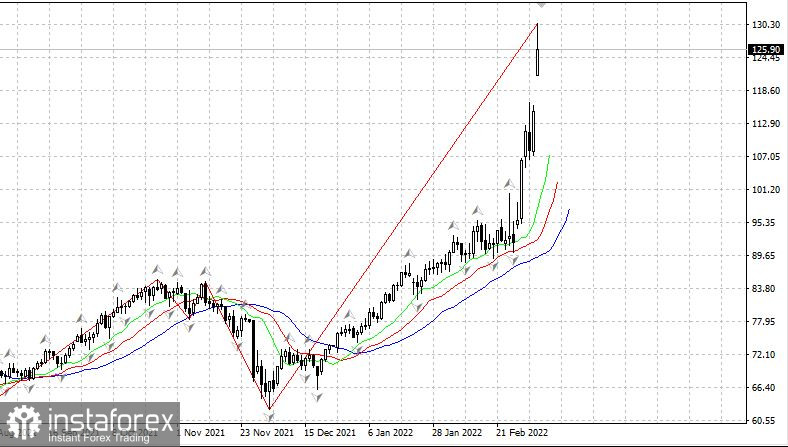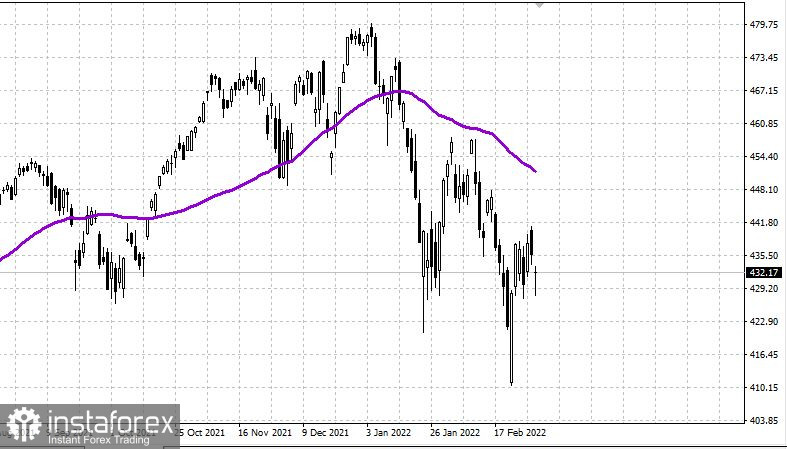
WTI futures (CL) as of early March 7

S&P500
Crude oil prices have reached $126 per barrel early on Monday as Ukraine holds the line against Russian advance. A new round of negotiations between Ukraine and Russia is expected in the near future.
The US stock market closed in negative territory on Friday, despite the non-farm payroll data greatly exceeding expectations. The US economy added 678,000 new jobs last month.
The Dow Jones lost 0.5%, the NASDAQ fell by 1.7%, and the S&P 500 decreased by 0.8%.
Asian markets fell early on Monday as well, with the Shanghai Composite and the Nikkei 225 losing 2.5% and 2.7% respectively.
The S&P 500 futures have declined by 0.7%, indicating that major indexes could fall at the bell today.
Oil prices have surged early on Monday. WTI futures (CL) jumped to $130 per barrel before retreating to $126. The benchmark Brent crude is trading at $129 per barrel, approaching the high of 2008. The European brand hit $147 per barrel in July 2008.
Russia's invasion of Ukraine and Western sanctions against Russia are pushing up commodity prices. The US and EU are now considering restricting Russian oil exports in response to the Kremlin's war against Ukraine. Oil consumers are buying commodity futures to protect themselves against soaring prices, boosting the price of crude oil. Russia produces about 12% of the world's oil supply.
Russian natural gas accounted for only 28% of EU's gas imports in January-February 2022, down from 47% in 2021. The EU and Germany is now preparing for Russia cutting down gas supply due to war in Ukraine.
Market players are awaiting the third round of negotiations between Russia and Ukraine, which are set to begin today. According to Ukrainian media, Kyiv strongly rejects Russian demands of recognizing its annexation of Crimea and the independence of the rebel regions of DPR and LPR. Yesterday, Russian president Putin had a phone call with French president Macron. Putin stated that Russia would reach its goals either via negotiations or by using military force.
Ukrainian defense is holding tenaciously against Russian attacks. The Russian offensive has bogged down in recent days, failing to surround Kyiv or take any major cities, with the exception of Kherson. In response to heavy Ukrainian resistance, Russia has intensified bombardments of Ukrainian-held towns and cities. Residential areas were hit by artillery and missile strikes, resulting in civilian casualties.
Western nations have imposed harsh sanctions against the Russian financial system and its banks. The foreign currency reserves of the Bank of Russia were frozen. The Russian ruble is at an all-time low against USD and EUR.
Due to the Russian central bank ban on transfers in foreign currencies outside of Russia, Rosneft is unable to make debt payments to Western banks. Recently, Vladimir Putin has signed an order allowing Russian companies to pay its debts to Western lenders only in RUB. However, it could be considered a default. Gazprom's debt payments are also due in the near future.
At this point, Western sanctions have failed to stop the Russian invasion. Ukraine has urged the West to impose a no-fly zone over its territory to deter Russian air and missile strikes. During the weekend, Russia destroyed the airport in the western Ukrainian town of Vinnytsya. The West has rejected calls for a no-fly zone, and has been hesitant to provide fighter jets to the Ukrainian air force. Although the US gave the green light for NATO member states to send combat aircraft to Ukraine on Sunday, Poland has called off the transfer. Warsaw is wary Russia could interpret it as NATO's direct intervention in the war.
The S&P 500 is trading at 4,329 and is expecting to be in the 4,300-4,370 range.
According to Friday's labor market data, 678,000 new jobs were created in the US in February. Unemployment fell to 3.8% from 4% in January.
The US market is under heavy pressure from the war in Ukraine and the resulting oil price upsurge. Soaring oil prices could boost inflation in the United States even higher. At the same time, the US is forced to seek new ways to help Ukraine defend itself against Russia, including restrictions against Russian oil exports. Major oil consumers have agreed to release 60 million barrels of oil to prevent a supply shortfall.
The US CPI data is due on Thursday – it will be the most important data release of the week.
USDX is trading at 98.80 and is expected to be in the 98.50-99.10 range.
The US dollar is pushing new yearly highs, as investors seek a safe haven asset to protect their assets from new market downturns caused by the war.
USD/CAD is trading at 1.2710 and is expected to be in the 1.2600-1.2800 range.
Soaring oil prices are weighing down on the pair. However, the pressure is counterbalanced by rising USD. USD/CAD is expected to remain within the price range.
World markets are hoping for a ceasefire in Ukraine, but the chances of successful negotiations between the two sides are low. The only major breakthrough they could agree on is protecting civilians from direct strikes on residential areas.





















